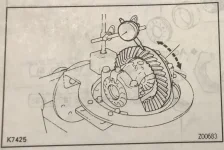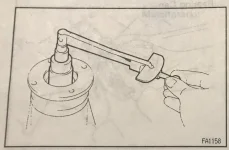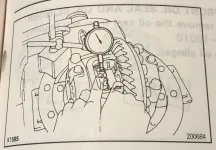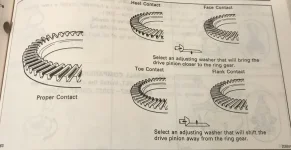It is a grave misconception common in this thread that thicker lubricants (in Lucas 85W140) merely (or solely) dampen whirring noise/whine , and .... random ?
My recommending (Lucas) 85W140 in your application is solely for components protection in the 'off target' differential operating behaviour divergent from intended performance parameters by increasing system operating viscosity ,operating MOFT, improved hydrodynamic vs reduced boundary lubrication regimes , etc etc .
Btw, Strange and East Coast Gear are also recommending Lucas 85W140 for their rebuilds ,as evidenced from several threads in this forum .
The noise dampening effect arising out of thicker lubricants is not the end, but an unintended by-product of this process of targeting/chasing after/achieving improved component protection and longevity .
I don't think you will ever need or require a rebuild with prolonged use of thicker lubricants (SAE 140 is preferred to 85W140 ,if it matters ) with potential elimination of whirring noise as experienced currently as time goes .
Zeng,
Respectfully, that’s not entirely correct. Let me explain why it isn’t and then show what is and why. I do lubrication assessments for a profession and there is a set and recognized methodology for this.
This is specifically on gearing and precisely on helical bevel sets (and you could include worms) because they are at the most extreme, but this applies universally for all gearing ( and most bearings) just in different percentages.
The “rule of thumb” in gear design is a ratio of RPM: Load. The higher the RPM, the lower viscosity- the higher the load the higher the viscosity.
The reason for that is the force to load profile of a gear through the transmission cycle. Gears are by definition boundary lubrication in nature and helical designs are the most extreme because they wipe and transfer energy not just an impact like the typical spurs and involutes.
The first duty of the oil is to literally fill up the tooth cavity and serve as an impact cushion for the incoming tooth, so the first function is in fact to buffer and initiate a severe decrease in velocities (under poisons model) that acts like a shock absorber. ( also addresses backlash and any potential back driving)
This is not as prevalent on helical designs but still present.
The reason is that on the gears line of force, the pitches hit and they “pivot” top and bottom of the flank and face so it’s more of a see saw than a slap.
By the time energy is being transferred there is virtually no film there to have strength so the MOFT argument doesn’t apply to a gear set. This is why gear lubes have EP additives that “microscopically explode” (a descriptive term) to lessen that metal to metal contact and other additives that put a sacrificial coating on them. It starts there yes but is quickly squeezed out preceding the tooth contact in helical sets.
This is the purpose of setting the contact patch relative to the design load relative to the transfer cycle relative to the flank/face geometry. If that is incorrect- no lubricant can overcome that eventual stress and wear. Even when correct, the lubricant will be squeezed out (plowed) during the cycle.
This is also why gears are expected to have surface pitting as part of normal service because there will be an element of surface fatigue that will cause pocking. They “pit” because of metal-to-metal surface hardening leading to surface fatigue (because of virtually no film during the contact cycle)
Thicker lubricants also tend to keep heat in the gears and thinner ones remove it better- the gear designer will make that determination when they decide the lubrication schema for that design because there is more than one correct way to build it but once built its difficult to change without modification.
( this is why we used to cringe on Falk boxes when people put Lucas or STP in them and said “yeah they cooled right down” until we tore them down and showed them that heat that WAS being released from convection of the case was now concentrated on the gear making it wear faster. It gave the ILLUSION of cooling when in reality was a damage enabler)
Regarding the damping of noise- get someone with a CSI 2140 or EU gun and let them demonstrate how various oils (with different bases and viscosities) adjust various noises. That’s done everywhere and is a common remedy in the field.
As far as ECG’s “recommendation”- their recommendations in their brochure are nothing more than highly opinionated garbage regardless of the quality of their product.
Any “recommended gear oil” has to be specified against the actual running and loading conditions of the gear set- not the properties of the oil in a “brand versus brand” contest.
I point this out because properties of any given oil (regardless of the property in question or the manufacturer) that do not directly address the requirements of a specific gear set simply don’t matter one way or the other regardless of they are “good, better or worse” than any other oil.
The gear set and its duty cycle combined with designed cooling, sump size etc. determines what properties and bases it needs for a lubricant- not reading a brochure.





